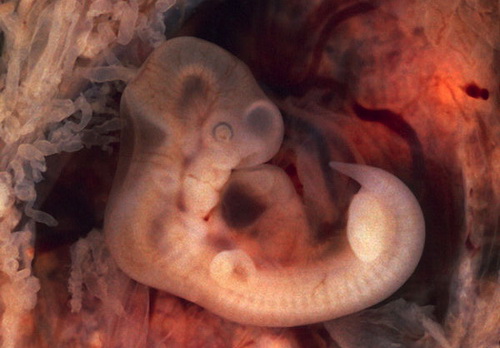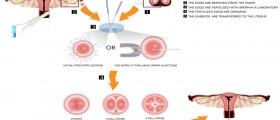
Miscarriage
Around 20 percent of all clinically recognized pregnancies end in miscarriage. If you count conceptions that terminated so early that the woman did not even know she was pregnant, the real figure is well over half of all pregnancies. These statistics make it clear that miscarriage is by far the most common pregnancy complication out there. "Miscarriage" is defined as any spontaneous pregnancy loss before 20 weeks gestation, though the majority of miscarriages take place within the first 12 weeks of pregnancy. Most miscarriages occur due to structural abnormalities within the embryo or fetus that are not compatible with life.
- Important notification about information and brand names used in this slideshow!
- Photo courtesy of Lau_Lau Chan by Flickr : www.flickr.com/photos/39315442@N06/4778643914/
- womenshealth.gov/pregnancy/you-are-pregnant/pregnancy-complications.html
- http://www.babycenter.com/0_7-pregnancy-complications-to-watch-out-for_10316818.bc
- http://www.cdc.gov/reproductivehealth/maternalinfanthealth/pregcomplications.htm
- http://americanpregnancy.org/pregnancycomplications/commoncomplications.html

Ectopic Pregnancy
An ectopic pregnancy is a pregnancy in which the fertilized egg implants outside of the uterus. The fallopian tubes are the most common site for an ectopic pregnancy, but ectopic pregnancies can also develop in the abdominal cavity, ovaries, or on the cervix. With the exception of certain types of abdominal ectopic pregnancy, these pregnancies can never be carried to viability. If an ectopic pregnancy does not naturally abort, the pregnancy has to be terminated surgically. This should happen as early on as possible, before the pregnancy becomes life-threatening to the mother. Ectopic pregnancy symptoms include sharp pain, vaginal bleeding and shoulder pain. Ectopic pregnancies can be detected once the patient shows symptoms, but they are also often detected during a routine ultrasound. Early detection of ectopic pregnancy is just one reason regular prenatal care is so important.
- Important notification about information and brand names used in this slideshow!
- Photo courtesy of Ed Uthman, MD by Wikimedia Commons : en.wikipedia.org/wiki/File:Tubal_Pregnancy_with_embryo.jpg

Premature Labor And Birth
Preterm labor and birth refers to deliveries that take place before 37 weeks pregnancy. Around half a million babies are born prematurely in the United States each year, and these babies can suffer from various health problems that require special care. The earlier a baby is born, the more likely it is that it will suffer from complex health problems. A history of premature labor, a twin or multiples pregnancy, and problems with the cervix or uterus are big risk factors for premature labor. Other risk factors include vaginal bleeding, sexually transmitted infections, high blood pressure, and smoking. Moms who are older than 35 are also more likely to go into labor prematurely.
- Important notification about information and brand names used in this slideshow!
- Photo courtesy of Marty Bonner by Flickr : www.flickr.com/photos/darkmarty/4225472849/

Preeclampsia
Preeclampsia is a complex pregnancy disorder that can become life-threatening very quickly. It is defined as protein spillage in the urine combined with high blood pressure after 20 weeks gestation. Though the cause of preeclampsia is not fully understood, the condition is probably created by an improperly functioning placenta in which the blood vessels don't work the way they should. The only "cure" for preeclampsia is delivering the baby. If left untreated, preeclampsia can turn into eclampsia or HELLP Syndrome, both of which threaten the life of mother and baby. Symptoms of preeclampsia include bad headaches, nausea and vomiting, vision changes and pain in your upper abdomen. Head for your maternity ward or call your OBGYN immediately if you notice these symptoms after you pass the 20 week mark.
- Important notification about information and brand names used in this slideshow!
- Photo courtesy of James G. (Boram) Kim by Flickr : www.flickr.com/photos/echo4ngel/578950711/

Gestational Diabetes
Gestational diabetes is diabetes that develops during pregnancy. Between two and 10 percent of expectant mothers develop gestational diabetes, which means it is one of the most common pregnancy complications. The condition is generally without symptoms, so it is important to participate in the glucose screening test that is carried out between 24 and 28 weeks into your pregnancy. Pregnant women who are diagnosed with gestational diabetes should follow special diets and exercise regularly. In some cases, medication is needed to manage gestational diabetes Having gestational diabetes does not mean you will be diabetic for the rest of your life — the condition goes away after you give birth.
- Important notification about information and brand names used in this slideshow!
- Photo courtesy of zeevveez by Flickr : www.flickr.com/photos/zeevveez/4823928047/

Placenta Previa
Placenta previa is a condition in which the placenta covers the cervix, partially or entirely. Since babies obviously have to pass through the cervix into the vaginal canal during a natural labor and delivery, placenta previa makes vaginal birth impossible. Unless a cesarean section is performed, babies would die and mothers left with a large risk of hemorrhage too. The main symptom of placenta previa is vaginal bleeding, though the condition is generally diagnosed following a routine ultrasound scan. It is not uncommon for a woman to have a low-lying placenta in the second trimester, but if it has not moved up toward the end of pregnancy, a c-section should be scheduled before labor has the chance to start naturally.
- Important notification about information and brand names used in this slideshow!
- Photo courtesy of lunar caustic by Flickr : www.flickr.com/photos/lunarcaustic/3739655032/

Hypertension (High Blood Pressure)
Gestational hypertension or pregnancy-induced hypertension (PIH) is high blood pressure that develops after the twentieth week of pregnancy, and without protein in the urine. High blood pressure combined with protein spillage warrants a preeclampsia diagnosis, while some women enter their pregnancy with chronic high blood pressure. High blood pressure during pregnancy should be managed with natural remedies whenever possible. Your doctor may suggest that you lower your salt intake, drink more water, and lie down on your left side to reduce the pressure your baby puts on major blood vessels. Your prenatal appointments should also be more frequent to monitor your condition. Not many hypertension drugs are safe during pregnancy, so women with chronic high blood pressure should discuss their treatment regime before they start trying to conceive.
- Important notification about information and brand names used in this slideshow!
- Photo courtesy of Emma Alonze by Flickr : www.flickr.com/photos/blackbird_pie/2774710705/

Rh Factor Difference
Are you Rh negative, while your baby's father is Rh negative? Your baby could be Rh positive, meaning you have an Rh incompatibility. If Rh negative blood comes into contact with Rh positive blood, the body will respond by producing antibodies to that blood. Once this has happened, the Rh negative person's blood becomes sensitized. Rh negative women who experience a first pregnancy are unlikely to be sensitized, but they should receive Rhogam to prevent this from happening, because sensitization can still affect later pregnancies. If you are Rh negative and already sensitized, while your baby is Rh positive, careful monitoring and possible blood transfusion are your best options. These babies may need to be delivered prematurely as well.
- Important notification about information and brand names used in this slideshow!
- Photo courtesy of U.S. Navy photo by Photographer’s Mate 3rd Class Jeremy L. Grisham by Wikimedia Commons : en.wikipedia.org/wiki/File:US_Navy_060105-N-8154G-010_A_hospital_corpsman_with_the_Blood_Donor_Team_from_Portsmouth_Naval_Hospital_takes_sam

Infections
Bacterial and viral infections of various kinds can always pose a threat to your health. During pregnancy, your immune system is weakened and you are more vulnerable to infections. Some infections can put your baby in great danger. Hepatitis B and C, rubella, chickenpox, HIV, and other sexually transmitted infections including chlamydia are just some of the infections that can cause serious complications during pregnancy. Even a cold sore (herpes) can pose a great risk to a newborn baby. It is always wise to be tested for various infections before you try to become pregnant, and to receive any booster vaccines you may need. During pregnancy, women should stay away from cat litter to avoid toxoplasmosis and refrain from eating raw and under-cooked meat and eggs. Group B Strep (GBS) is another infection that can be life-threatening for your baby, so you'll be tested for this toward the end of your third trimester. Your OBGYN will be able to give you more information about specific infections and how to prevent or treat them.
- Important notification about information and brand names used in this slideshow!
- Photo courtesy of Sandra Thomson by Flickr : www.flickr.com/photos/justyouphotography/4145515758/

Depression (During Pregnancy And Postpartum)
Prenatal and postpartum depression may not be as obviously dangerous as premature labor, placenta previa, or preeclampsia but depression can most certainly be life-threatening to mothers and babies alike. If you have suicidal thoughts during pregnancy or the postpartum period, don't feel anything positive toward your pregnancy or baby, and do not enjoy life any more, please seek medical advice. Prenatal and postpartum depression are caused by hormonal imbalances and do not indicate that you are a bad mother. These forms of depression are treatable with the right help, so do not suffer in silence.
- Important notification about information and brand names used in this slideshow!
- Photo courtesy of Sean by Flickr : www.flickr.com/photos/busbeytheelder/5319332951/



























Your thoughts on this
Loading...